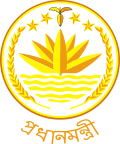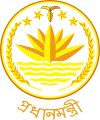Prime Minister of Bangladesh facts for kids
Quick facts for kids Prime Minister of the People's Republic of Bangladesh |
|
|---|---|

Standard of the prime minister of Bangladesh
|
|

Seal of the prime minister of Bangladesh
|
|
|
Incumbent
Vacant since 5 August 2024 |
|
|
|
| Style |
|
| Abbreviation | PM |
| Member of |
|
| Reports to | |
| Seat | Primary: Prime Minister's Office, Old Sangsad Bhaban, Tejgaon, Dhaka Secondary: Bangladesh Secretariat, Segunbagicha, Dhaka |
| Appointer | President of Bangladesh by convention, based on appointee's ability to command the confidence of the Jatiya Sangsad |
| Term length | At the pleasure of the president
Jatiya Sangsad term is 5 years unless dissolved sooner
No term limits |
| Constituting instrument | Constitution of Bangladesh |
| Inaugural holder | Tajuddin Ahmed |
| Formation | 17 April 1971 |
| Deputy | Deputy Leader of Jatiya Sansad |
| Salary | ৳305000 (US$3,300) per month (incl. allowances) |
The prime minister of Bangladesh (Bengali: বাংলাদেশের প্রধানমন্ত্রী) is the head of government for Bangladesh. This means they lead the country's government. The prime minister and the cabinet (a group of top ministers) are responsible for their decisions to the Parliament. They are also accountable to their political party and, most importantly, to the people who elected them. The president of Bangladesh formally appoints the prime minister.
Sometimes, the military took control of the government in Bangladesh. This happened during periods like 1975–78, 1982–86, and 1990–91. During these times, the military leaders held the main power. Between 1996 and 2008, a special "caretaker government" was in charge for 90 days before elections. This temporary government was led by a "chief adviser." This system was stopped in 2011. However, in December 2024, the Supreme Court of Bangladesh declared this change illegal.
Sheikh Hasina was the longest-serving prime minister in Bangladesh's history. She resigned on August 5, 2024, after widespread protests. This left the position empty.
Contents
How the Prime Minister is Chosen
Appointment Process
The Constitution explains how the prime minister is chosen. After a general election, the president appoints the prime minister. The prime minister is usually the leader of the political party or group that wins the most seats in the Jatiya Sangsad (Parliament). This person must have the support of the Parliament to lead the country.
Forming the Cabinet
The prime minister chooses other ministers to form the cabinet. The president then officially appoints these ministers. Most ministers (at least 90%) must be members of Parliament. A small number (up to 10%) can be experts who are not MPs. The president can end the Parliament's term if the prime minister asks in writing.
Taking the Oath
When appointed, the prime minister takes an oath. This is a promise to faithfully serve the country.
English Oath
I, (name) do swear with honor (or solemnly affirm) that I, according to the laws, shall faithfully discharge the functions of the office of the Prime Minister (or Minister or State Minister or Sub-minister, as the circumstances allow). I shall possess pure faith and obedience to Bangladesh. I shall preserve, support, and secure the constitution and deal with all with equity as suggested by laws, without being affected by fear or mercy, love or hatred.
What the Prime Minister Does
Prime Minister's Office
The main office of the prime minister is in Tejgaon, Dhaka. This office acts like a government department. It helps the prime minister with daily tasks, security, and official events. It also helps manage intelligence matters and non-governmental organizations (NGOs).
Key Responsibilities
The prime minister is usually in charge of several important areas. These include:
- Leader of the House: Managing government work and schedules in the Parliament.
- Cabinet Division: Overseeing the work of all government ministries.
- Armed Forces Division: Leading the country's military and defense.
- Ministry of Power, Energy and Mineral Resources: Managing the country's power, energy, and natural resources.
- Planning Commission: Leading the group that plans for the country's development.
- Bangladeshi intelligence community: Overseeing national security intelligence.
History of the Prime Minister's Role
Early Years and Independence (1971–1975)
Bangladesh was once part of British India, known as Bengal. After India's partition in 1947, it became East Pakistan. This region faced political challenges. The modern role of prime minister began when Bangladesh declared independence on April 17, 1971. Tajuddin Ahmad became the first prime minister of Bangladesh. The official title became "prime minister of the People's Republic of Bangladesh" with the 1972 Constitution.
Military Rule (1975–1991)
From 1975 to 1991, the president held most of the executive power. During this time, the prime minister was appointed by the president.
Return to Parliamentary Government (1991–Present)
In September 1991, the people approved changes to the Constitution. This brought back a parliamentary system, giving the prime minister more governing power. In October 1991, Parliament elected Abdur Rahman Biswas as the new president.
Khaleda Zia's Time as Prime Minister (1991–1996, 2001–2006)
Khaleda Zia served as prime minister twice. Her governments made important changes in education. These included free education for girls up to 10th grade and financial support for female students. Her government also spent a lot on education.
She became prime minister again in 1996 after an election. However, many major parties did not participate in this election. They wanted a neutral caretaker government to oversee the elections. In the June 1996 elections, her party lost to the Awami League.
In 1999, her party formed an alliance with other parties. They worked together against the ruling Awami League. In the 2001 general elections, her party won a large majority. Khaleda Zia was sworn in as prime minister again. In the 2008 election, her party faced a significant defeat.
Sheikh Hasina's Time as Prime Minister (1996–2001, 2009–2024)
Sheikh Hasina became prime minister in June 1996. Her party, the Awami League, won enough seats with support from other parties. She promised to create a "Government of National Unity."
In the 2001 election, the Awami League lost. Sheikh Hasina and her party did not accept the results. However, international observers generally found the elections acceptable.
In the December 2008 election, Sheikh Hasina's Awami League won a huge victory. They formed an alliance that won most of the seats. Sheikh Hasina became prime minister on January 6, 2009. She continued as prime minister after the January 2014 election, which her main opponent's party boycotted.
Sheikh Hasina secured a fourth term as prime minister after winning the 2018 general election. She became the longest-serving prime minister of Bangladesh since the country's independence. After widespread protests against her government, Sheikh Hasina resigned and left Bangladesh on August 5, 2024.
Prime Minister's Pay and Benefits
The prime minister of Bangladesh receives a monthly salary. According to a 2016 law, this salary is 115,000 Taka per month. They also get a monthly house rent allowance of 100,000 Taka and a daily allowance of 3,000 Taka.
See also
 In Spanish: Primer ministro de Bangladés para niños
In Spanish: Primer ministro de Bangladés para niños
- Chief Adviser of Bangladesh
- Constitution of Bangladesh
- List of prime ministers of Bangladesh
- Politics of Bangladesh
- President of Bangladesh
Images for kids



